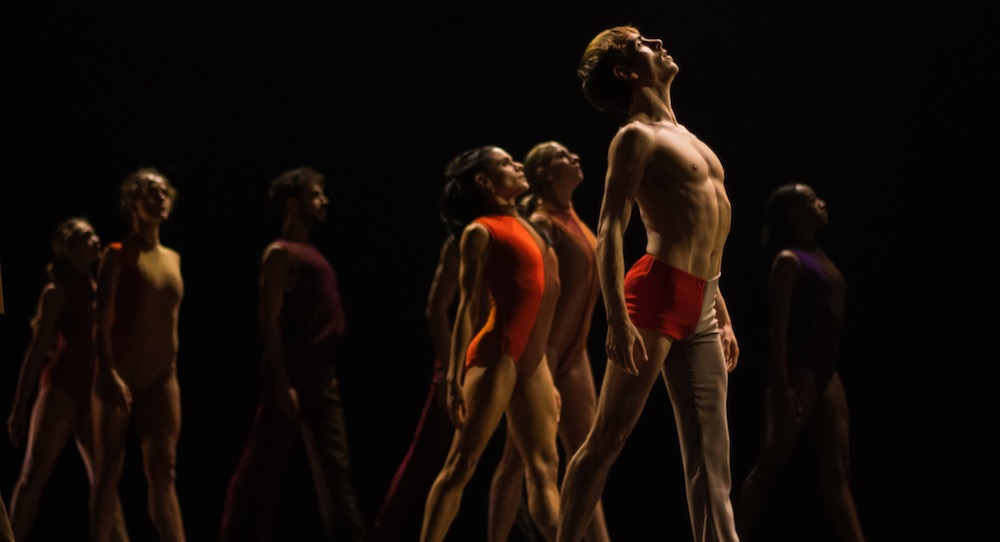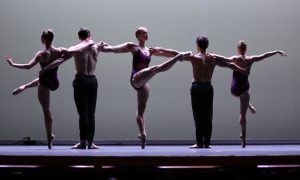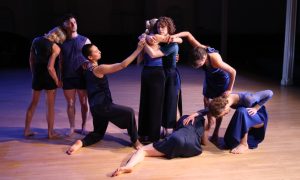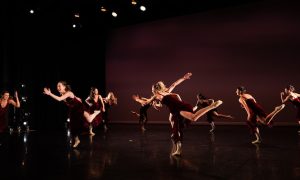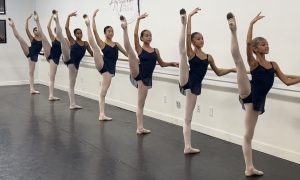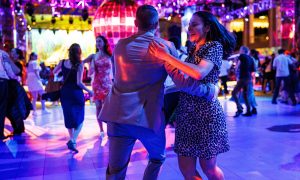The Joyce Theater, New York, NY.
November 26, 2022.
Spending time in NYC to see world-class dance is one of the true treasures of my life, when I can make it happen. This was the first time I was booked to see the seminal Complexions Contemporary Ballet, at the company’s annual season at the iconic Joyce Theater — for me, experiencing the company’s work for the first time (or at least a full program of it, live and in-person). I expected something beautiful, something striking, something memorable – and all of that it was.
Yet, I didn’t quite know just how much the program would draw me to think and to discover, with respect to dance as an art form and how I receive it. I didn’t quite realize how much the peak of athletic artistry on offer would speak to me – but how much I also craved something softer, something more quotidian, something more human. I didn’t know that this program would help me to see, unlike ever before, the beauty of virtuosity’s height – but also the beauty of slowing down.
The first act presented Dwight Rhoden’s Hissy Fits (2006), a piece of striking athleticism as well as space for deeper commentary on who we are – and aren’t – as humans. The score (from Bach) began with mysterious, even foreboding qualities: deep staccato notes ringing through the theater in between spaces of silence. The movement, however, kept going through those silent spaces: vigorous, athletic, fast.
In the context of the piece, Rhoden didn’t wait to give the dancers movement vocabulary that could illustrate their full technical prowess. In fact, Rhoden’s choreography was so continuous, so athletic, so driven that it seemed as if an outside force was propelling the ensemble; “can’t stop, won’t stop!” came to mind for me. “Hissy fits”: those times when emotions overcome us and it’s not us in control anymore – the emotion is.
Turns like a perfectly spun top, lines lifting like rockets and descending like fall leaves, spines pliable as clay molded by the hands of an expert potter: the dancers’ technical strength and artistry continued to captivate me. Rhoden’s partnering also stood out as a clear strength; he has a true knack for bringing two bodies together in space in kinetically harmonious ways.
I did begin to wonder, however, if there can be too much of a good thing there. A friend who came to the show with me said it well: the eyes (and the mind, heart and spirit, really) need a moment to absorb and appreciate before experiencing the next wow-worthy technical feat. Thankfully, just when I was feeling like it was time for it, movement slowed down and stepped back an inch or two on virtuosity.
The tone and feel in the air shifted from time to time, with changes in lighting (lighting design by Michael Korsch) and score – and the shift to something a pinch more pedestrian in movement quality – came with one of those atmospheric shifts. Waves of calm can be possible even within a storm. Faster, more vivacious movement returned before too long. At least it was all cohesive with the score, and overall quite pleasing, I thought. A repeated phrase brought to mind for me cycles, of – without conscious will – repeating patterns (“hissy fits” or otherwise). I thought again about being driven from the outside.
One formation in particular also caught my eye around this point of the piece: a horizontal line across the stage, with dancers facing downstage, tugging and releasing one another as well as changing levels. This was a wave of emotion and actions – sometimes cloaked in mystery (the dancers stayed facing upstage, their faces hidden from us in the audience).
That formation didn’t last long, however; structuring of dancers in groups and in space was as mercurial and dynamic as the movement vocabulary itself. Towards the end of the work, I did sense more moments of the virtuosity softening – more satisfying sustainment of movement. Or, I wondered, was I just getting more used to the highly speedy, athletic quality at hand here? I reflected a little on being acclimated to art as we experience it, the initial awe softening with time.
Then I got pulled back into the magic on stage. The atmosphere got more romantic – sweeping, emotional – toward the end. Balancing and counterbalancing of weight spoke to support. Dancers crossed and uncrossed limbs, confined and released themselves. What part does our own agency, the ways in which we liberate or constrain ourselves, have to play? That’s food for thought indeed. Movement vocabulary from prior sections also returned, speaking to old patterns rearing their heads again.
The work ended with the dancers in silhouette, holding hands in line. Physically, and under lights, they were caught, confined. Do our “hissy fits” confine us? Do we confine ourselves by them? The curtain dropped, and I was left with these weighty, thought-provoking questions to sit with – as well as discuss with my friend as we chatted before the curtain rose again for Act II.
That brought us Snatched Back from the Edges (2021), another Rhoden work. The work began with two subsequent solos in spotlights, at opposite sides of the stage. The movement here offered a sweet swinging sense, of release and rebound. The spotlights soon merged, and more dancers joined: separate kinetic experiences merging. The atmosphere pulsed with uncertainty; with dancers lit from behind, their expressions were slightly veiled (lighting design by Korsch).
Yet – mainly because of the clear light sources and the dancers’ sense of assured, yet fluid strength – hope was also at hand. Through formations such as a line of dancers at one side of the stage and another line at the other, them facing in toward one another, I sensed tension – but also the presence of a sincere community.
Other formations – such as dancers in a line moving toward and away from others, like moving parts of brambles in a hedge – offered myriad layers to peel back and take in. Increasing that sense of multiplicity, a group of dancers shifted into the next group of dancers quite quickly. “Snatched back from the edges”: for a beat, I reflected on those moments when it’s all on the line – and we didn’t see it coming. When, in a flash, everything could change. Then, just as during the first work in the program, the dazzling physical feats on stage took back my full attention.
With all of those effective qualities and choices, I still craved a bit more softening of the virtuosity in the movement vocabulary – the speed, the level of technical challenge, the intricacy – on offer. As with Hissy Fits, I felt like I couldn’t fully absorb it all, and I wanted to – because I could take in enough (more than enough, really) to know that it was magical.
The artistry of the dancers, the kinetic harmony that Rhoden created in movement pathways and transitions: I wanted to truly appreciate it all. It all felt like one of those phenomenon that make you marvel at what the human body, the human mind, the human soul can accomplish. Atmospheric shifts, such as a memorable one into a jazz night club feel (with lights lowering and turning to blue and purple color scheme), also kept me riveted. Some female dancers in pointe shoes, in a few of the middle sections, added another compelling element: of levels, sound and energy.
Then, something shifted. The beginning’s alternating spotlights, and the spotlights merging (with the dancers who had been in them, as well), returned. There started to be pauses, space for ease and longer breath. Pedestrian movement emerged – for example, simple walking patterns of some dancers upstage while others danced more technical movement farther upstage. Lyrics in the R&B score spoke to leaving behind negativity and toxicity – the things that take us down (or at least try to).
Some dance connoisseurs might have found that sentiment overly saccharine and literal, but I was feeling uplifted, inspired – plain and simple. With that easing of virtuosity, it blending with more pedestrian (and simply human) movement, I could finally feel true heart and soul. With all of the beauty and wonder at hand in the program thus far, it hit me then: this is what I had wanted until then, without really even knowing it.
Looking at it all with curiosity, with an open mind, all of Rhoden’s choices might very well have been towards a specific message or atmosphere: and that all came together quite well. Yet, from the lens of audience experience, this shift to a softer, more human tone: for me, that’s where the good stuff really was. So good, in fact, that I felt like I could have come to theater that day for just that last half of the second work and been more than satisfied.
The ending only solidified that feeling for me. Dancers held hands, in a line going horizontally across the stage, walking to upstage: united, courageous, strong. Before the lights went down, they – all together – looked to us in the audience. It felt like a challenge, a call to action; would we be snatched back from the edges? By ourselves, by those in our lives who love us? Would we leave behind toxicity and negativity, and stop being dragged down? After the lights went down, I leapt to my feet and couldn’t clap enough.
Reflecting further, as my friend and I gathered our things and started to leave the theater, this came to mind, clear as sunlight: just because dancers can do something, doesn’t mean that it serves the work for them to do that thing. When you have a hammer, everything looks like a nail; when you have astoundingly virtuosic dancers, every moment in a work looks like an opportunity to use their gifts. Yet, is dance a vehicle solely for athleticism, or humanity through athleticism?
These were all questions to ponder, rather than any judgement. I was grateful for Rhoden’s courage of conviction when it came to translating a message and an atmosphere – yet skillfully, not in an overbearing way (most audience members don’t like being whacked over the head with a meaning, after all).
I also commended his willingness to take risks in movement vocabulary and virtuosity – testing the limits of his dancers’ possible. I was dazzled by their highly athletic, highly committed artistry. For that – and even for a clearer sense of what draws me, what truly gets into the nooks and crannies of my soul, when it comes to dance art – sincere gratitude and brava, brava, brava to Complexions Contemporary Ballet for its 2022 season at the illustrious Joyce Theater.
By Kathryn Boland of Dance Informa.


